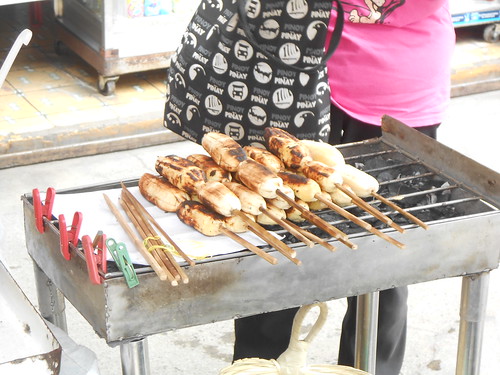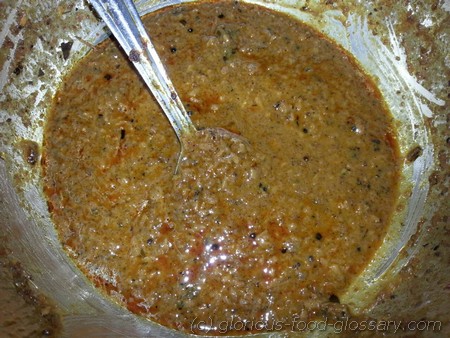Glossary I
Deutsch: Gegrilltes Huhn / Español: Pollo a la parrilla / Português: Frango grelhado / Français: Poulet grillé / Italiano: Pollo alla griglia
Inihaw na Manok in the food context refers to a Filipino dish of grilled chicken. This popular dish is known for its flavorful marinade, which often includes soy sauce, vinegar, calamansi juice (a Philippine lime), garlic, sugar, salt, and pepper, infusing the chicken with a distinctive savory taste with hints of sweetness and tanginess. The chicken is then grilled over charcoal, giving it a smoky aroma and slightly charred exterior while keeping the inside tender and juicy. Inihaw na Manok is a staple at Filipino gatherings, reflecting the country's rich tradition of barbecued and grilled foods.
- Inihaw na Saba / Inihaw na Saging na Saba:
Inihaw na Saging na Saba (grilled plantain or cooking banana called Saba in the Philippines) refers to a Filipino snack made of Saba, a cooking banana variety, peeled and skewered and cooked over charcoal. It is made of half ripe banana, when the banana is still a bit unripe and still a bit tough and not so yellow and overipe.
It is called in different dialect in the Philippines as Hawob in Davao and Ginanggang/Guinanggang in the Visayas, in Cebu particularly, which means grilled, which is Inihaw in Tagalog.
Inihaw na Saging na Saba is often found in the Tagalog- speaking region of the Philippines, like Laguna and Marinduque. They are sold as street foods.
Some said that this is a boring snack compared to other Filipino banana snack, like Turon at Minatamis na Saging with milk and shaved ice, but I learned to like it, with just enough ripeness and sweetness, I think this is a healthy snack option. Maybe I enjoy eating Inihaw na Saba because it reminds me all the time of my summer vacations in the home province of my mother where my grandfather lived until he died. It was my grandfather who bought the first Inihaw na Saging na Saba which I ever tasted while walking along the beach in Torrijos, Marinduque.
In San Pablo City, Laguna where I kept a home, there are lots of vendors selling "inihaw na saging”. I have not eaten Inihaw na Saba for a long time now, I have not found Saba in Germany, only cooked and packed boiled Saba imported from Vietnam in my favorite Asian store in my city, but there is nothing quite like our Inihaw na Saba. Soon I am home, I hope to be able to find time to travel around my country and enjoy once again its great culture.

Deutsch: Gegrillter Tilapia / Español: Tilapia a la parrilla / Português: Tilápia grelhada / Français: Tilapia grillé / Italiano: Tilapia alla griglia
Inihaw na Tilapia in the food context refers to a Filipino dish of grilled tilapia. Tilapia, a freshwater fish known for its mild flavor and firm texture, becomes the centerpiece of this dish, which is often prepared by marinating the fish in a Blend of soy sauce, calamansi juice (or lemon), garlic, and sometimes vinegar or other spices before grilling over charcoal or an open flame. The process imparts a smoky flavor to the fish while keeping the inside moist and flaky. It's a popular method of cooking tilapia in the Philippines, especially given the fish's availability and the Filipino penchant for grilled foods.
Deutsch: Gegrillter Schweinebauch / Español: Panceta de cerdo a la parrilla / Português: Barriga de porco grelhada / Français: Ventre de porc grillé / Italiano: Pancia di Maiale alla griglia
Inihaw na Tiyan ng Baboy in the food context refers to a Filipino dish of grilled pork belly. This dish is celebrated for its succulent meat and crispy skin, achieved through marinating and slow-grilling over charcoal. The pork belly is typically marinated in a mixture of soy sauce, vinegar or calamansi juice, garlic, and various spices that infuse it with flavor. This preparation method not only tenderizes the meat but also imparts a smoky taste that's characteristic of Filipino barbecue.
Inji, commonly known as ginger, is a versatile and widely used spice and herb in the culinary world. It adds a unique flavor and aroma to dishes, making it an essential ingredient in many cuisines. In this article, we will explore the world of Inji, its culinary uses, potential health risks, and historical significance. We will also provide a popular recipe that showcases the delightful taste of ginger.
English: Ginger Tamarind Pickle / Deutsch: Ingwer Tamarinden Pickles / Español: Encurtido de jengibre y tamarindo / Português: Condimento de gengibre e tamarindo / Français: Pickles de gingembre et tamarin / Italiano: Sottaceto di zenzero e tamarindo /
Inji Puli Achar is a special pickles from Kerala, India made basically from chopped or grated Inji (Ginger) and Tamarind (Puli) or Tamarind Paste cooked with lots of spices like any other Achaar/Achar from Kerala. (Please see related article on Achar/Achaar)
Inji Puli Achar is mostly prepared for big and very important festivities, like Onam and Wedding feast. It was one of the Pickles (Achar) prepared during the wedding of one of my second family member in Allepey, a district in Kerala.
Below is a picture of Inji Puli served during the said wedding. Can be seen clearly are Black Mustard Seeds (Kadugu) which is one of the spices used for making Achar/Achaar.

